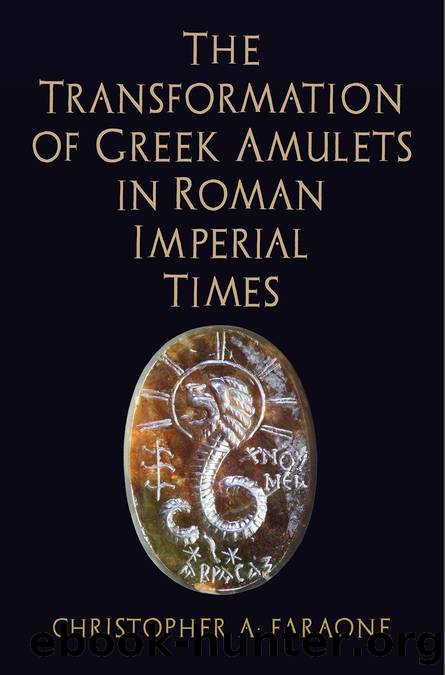The Transformation of Greek Amulets in Roman Imperial Times by Christopher A. Faraone

Author:Christopher A. Faraone [Faraone, Christopher A.]
Language: eng
Format: epub
Tags: Esoteric, History, Non-Fiction
ISBN: 9780812249354
Google: Ti1NDwAAQBAJ
Barnesnoble:
Goodreads: 35926691
Publisher: Libre Dionysia
Published: 2018-04-20T04:00:00+00:00
6.4 Isis Lactans and Isis-Fortuna
Like Harpocrates, Isis appears in two distinct poses on amulets, the seated image of Isis Lactans (an older Pharaonic form), and the standing Ptolemaic type in Greek dress who was assimilated in the Hellenistic and Roman periods with various Greek godsâfor example, Isis-Demeter, Isis-Aphrodite, or Isis-Tyche. Isis-Tyche, whom scholars often call by the Latin version âIsis-Fortuna,â seems to have been most popular in the eastern Mediterranean. We have already seen her, in rare monumental stature, at the center of the late antique lararium pictured in Figure 6.1, where as usual she stands in full Greek dress with a cornucopia in her left hand and a shipâs steering oar in her right.[722] These attributes, moreover, point to her ability to increase prosperity and to provide safe passage at seaâboth of which, as we have seen, were the goals of other amulets. There is, however, a persistent difficulty in distinguishing Isis-Fortuna from Tyche herself: the image in the lararium, for example, holds the oar and the cornucopia of Tyche and sports as well a special kind of royal headgear (the basileion) worn by Isis, but she does not display the characteristic âIsis knotâ that often, but not always, distinguishes Isis from the earlier Greek goddess.[723] The earliest images of Isis-Fortuna appear on rings in the second century BCE, and by the imperial period, they become particularly popular in small statuettes of bronze and silver (Figure 6.7). This Hellenized version of Isis became, finally, the central focus of a major Roman-era mystery cult, where her interest in âsavingâ her worshippers fits yet another pattern of amulet use that will be discussed in detail in Sections 7.6 and 8.2: texts or divine names associated with mystery cults engraved on amulets for health or protection.[724] Her newly expanded salvific powers are trumpeted in one of the hymns that Isidorus inscribed in Greek in the early first century BCE: âDeathless Savior, many-named, mightiest Isis, who saves from war cities and all their citizens, men, their wives, possessions, and children, as many as are bound in prison, in the power of death, as many as are in pain through long anguished, sleepless nights, all who wander in a foreign land and as many as sail on the great sea in winter.â
The evidence for the amuletic power of her images is, however, supported only by circumstantial evidence or âguilt by associationââfor example, when she is placed in monumental size in the center in the lararium mentioned above, when a miniature statue of her is the sole attachment to a large gold bulla found in Rome
Download
This site does not store any files on its server. We only index and link to content provided by other sites. Please contact the content providers to delete copyright contents if any and email us, we'll remove relevant links or contents immediately.
| Africa | Americas |
| Arctic & Antarctica | Asia |
| Australia & Oceania | Europe |
| Middle East | Russia |
| United States | World |
| Ancient Civilizations | Military |
| Historical Study & Educational Resources |
The Daily Stoic by Holiday Ryan & Hanselman Stephen(2708)
The Fate of Rome: Climate, Disease, and the End of an Empire (The Princeton History of the Ancient World) by Kyle Harper(2436)
People of the Earth: An Introduction to World Prehistory by Dr. Brian Fagan & Nadia Durrani(2346)
Ancient Worlds by Michael Scott(2103)
Babylon's Ark by Lawrence Anthony(2070)
Foreign Devils on the Silk Road: The Search for the Lost Treasures of Central Asia by Peter Hopkirk(2056)
India's Ancient Past by R.S. Sharma(1987)
MOSES THE EGYPTIAN by Jan Assmann(1972)
The Complete Dead Sea Scrolls in English (7th Edition) (Penguin Classics) by Geza Vermes(1840)
Lost Technologies of Ancient Egypt by Christopher Dunn(1797)
The Daily Stoic by Ryan Holiday & Stephen Hanselman(1768)
The Earth Chronicles Handbook by Zecharia Sitchin(1744)
24 Hours in Ancient Rome by Philip Matyszak(1678)
Alexander the Great by Philip Freeman(1648)
Aztec by Gary Jennings(1545)
The Nine Waves of Creation by Carl Johan Calleman(1520)
Curse Tablets and Binding Spells from the Ancient World by Gager John G.;(1510)
Before Atlantis by Frank Joseph(1484)
Earthmare: The Lost Book of Wars by Cergat(1468)
